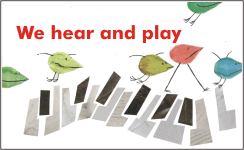
Click to return to the home page
Music literature, when discussing piano methods or music psychology, sometimes refers to absolute pitch, also known as “perfect pitch.” Absolute pitch is the ability to recognize a specific musical pitch without a reference tone. Many authors believe that absolute pitch is an innate, genetic capacity which can’t be learned. Our extensive experience contradicts this. We shall show that absolute pitch is a skill that can be learned.
This handbook doesn’t intend to exaggerate the significance of absolute pitch. We wish to explore the possibilities that it offers for musical training, and to observe the phenomenon studiously.
For a healthy, normal child, absolute-pitch instruction should begin no later than age 4½. Ideally, a child will start at age 3. If a child begins to develop their ear at this age, following our methods, after only one year they will acquire the basis for absolute pitch. They will possess absolute pitch after approximately two years. If they continue to study music, their ear continues to develop even further. Adults typically don’t expect that a child can learn absolute pitch, so they neglect this most favorable stage of development. If instruction begins after a child is 4½ years old, success is not guaranteed.
Our curriculum also teaches the child to play the piano while they are learning absolute pitch. The piano is the best instrument for absolute-pitch education. The child’s family should own a relatively new piano that they keep precisely tuned and in good condition, or absolute pitch training is impossible. For the lessons, parents should use our three-volume publication We Hear and Play, which we developed through extensive work with children. This work made clear how children may be taught absolute pitch, as a basis for early musical training. On completing our course, a child may continue to develop their piano skills or may change to any other instrument.
In We Hear and Play sounds are associated with colors. Therefore, the child being trained must be able to distinguish and name colors. A child between 3 and 3½ years old can normally do this.
Our instructional method is designed for tutoring a single child, because each child in a group is likely to be at a different stage of development. This makes it impossible to be sure of providing everything they need.
The instructional atmosphere must be positive. This is critical. Children can only be trained if the process is enjoyable and fun. Only then will they be ready to cooperate. Mechanical drilling or forced instruction can quickly teach children to dislike the training and resist achievement.
For this method to succeed, the teacher’s personality is decisive. The teacher must be loving, patient, and inventive; above all, they must respect the childlike personality. This handbook describes our teaching objectives in detail and provides practical advice. Within this pedagogic structure, every teacher must identify the essential training points and find appropriate ways to present the material to each child.
Teaching preschool children calls for a large commitment. Despite the simple appearance of the instructional material, the task is demanding and requires an intensive relationship. The teacher must be aware of their responsibility for the child’s developing personality. Based on this awareness, the use of this method enriches children, parents, and teachers alike.
Will the children who are given this training become the musical elite of the future? Not necessarily. This material is not intended to make all students into musicians. We created this process to enrich any child’s lifelong understanding of the world of music.
We want to thank the Ettlingen Music School and the Mainz Academy for Music Pedagogics, who promoted this instructional work, as well as all the piano educators who have reported to us their experiences of training children with this method. With much gratitude, we remember Mr. Lothar Friedrich, the Schott publishing house lecturer who supported We Hear and Play even from its origin phase. He passed away all too soon.
- Naoyuki and Ruth Taneda
Preface by Christopher Aruffo
Frequently Asked Questions about Absolute Pitch
Introducing Traditional Notation, part 1